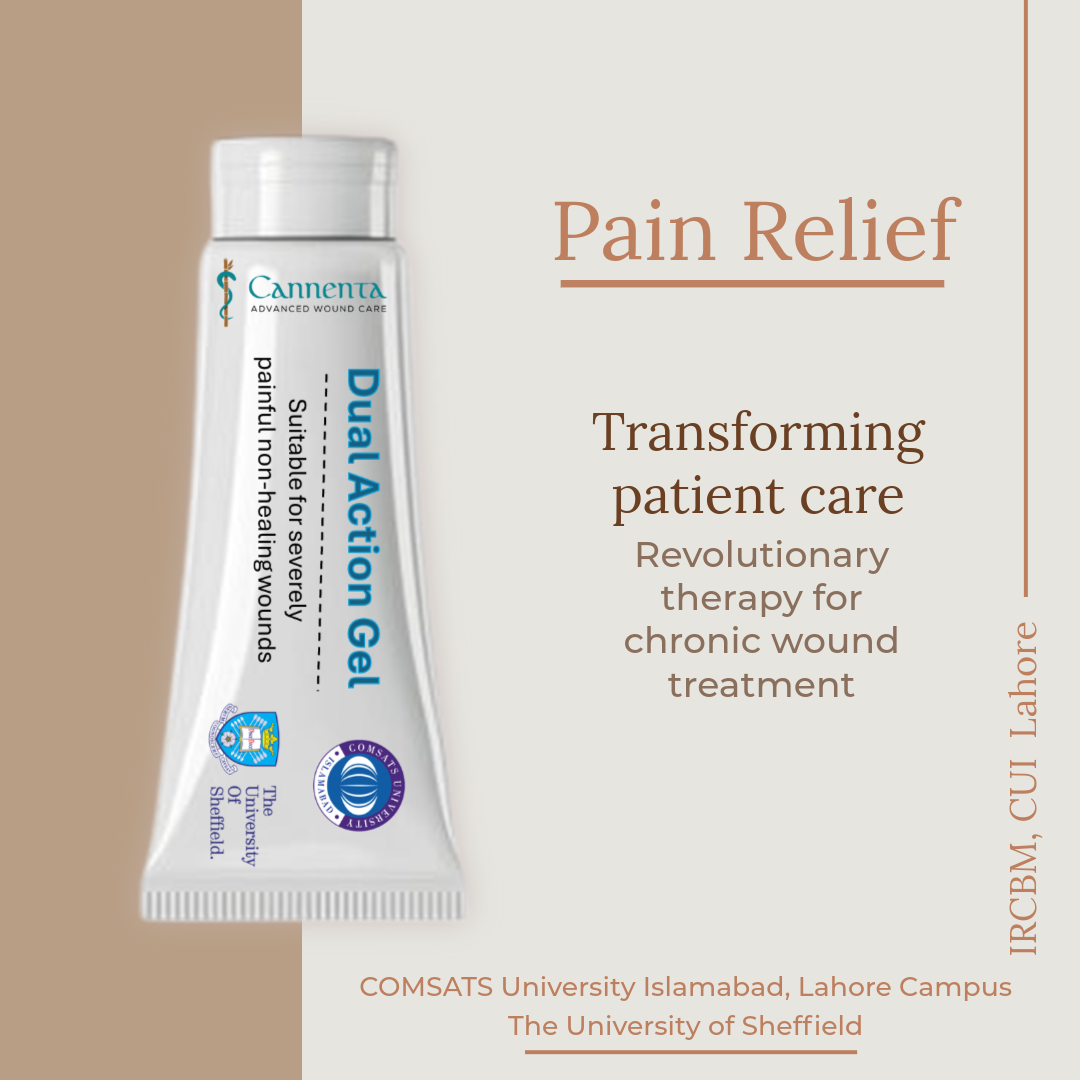Breakthrough Dual-Action Therapy for pain relief and wound healing from COMSATS University Pakistan and The University of Sheffield UK Redefines Painful Chronic Wound Treatment Worldwide
In the rapidly evolving world of wound care where patient care with innovation is the main player, we have developed a comprehensive wound care solution. A team of researchers led by Professor Muhammad Yar (T.I.) at IRCBM COMSATS University Islamabad, Lahore Campus and Emeritus Prof Sheila MacNeil at The University of Sheffield UK dedicated their energies to formulate.
- An innovative 2 deoxy-D-ribose (2dDR) and Lidocaine Gel as a single, advanced formulation that combines the regenerative power of 2dDR with the fast-acting pain relief of Lidocaine — delivering comprehensive care in just one easy-to-apply treatment
- Dual functionality: Healing and pain management in one
- Enhanced compliance: Reduced patient discomfort leads to better adherence to wound care protocols
- Easy application: Gel format ensures uniform coverage and ease of use in clinical or home settings
- Versatility: Suitable for both acute and chronic wounds across a range of clinical scenarios
- Affordable treatment: As a single solution for pain relief and wound healing it reduces wound treatment costs.

Need to re-define the wound care: instant relief meets vascular repair
Chronic and painful wounds are a growing global health crisis, affecting over 300 million people worldwide, with conditions like diabetic ulcers, pressure sores, and surgical wounds increasingly common in aging and diabetic populations. Alarmingly, up to 70% of these patients suffer from unmanaged wound pain, significantly impairing quality of life and recovery. In response, researchers from COMSATS University Islamabad and the University of Sheffield took the imitative to develop a dual action wound healing innovation that not only provides instant pain relief but also accelerates healing through angiogenesis. This breakthrough enters a market projected to surpass USD 25 billion by 2027, where demand for smart, multifunctional wound care solutions is rapidly growing. Even a modest 1% global market share positions this technology for USD 250 million in annual earnings, highlighting its immense therapeutic and commercial potential.
Pain relief is essential in treating highly painful wounds, as unmanaged pain can delay healing, increase stress, and reduce patient compliance with care. Effective pain control not only improves comfort but also supports faster recovery, better outcomes, and a more positive overall treatment experience. Current pain relief solutions in wound care often rely on oral analgesics or separate topical anesthetics, which may offer delayed or inconsistent relief. These approaches are cumbersome and may not fully address pain during dressing changes or ongoing wound care. Besides pain management, angiogenesis, the formation of new blood vessels from existing vasculature, is a critical process in wound healing. It ensures the delivery of oxygen, nutrients, and immune cells to the wound site, which are essential for tissue regeneration and repair. Without adequate angiogenesis, wounds may become ischemic, leading to delayed healing or chronic non-healing wounds, especially in conditions like diabetes. Stimulating angiogenesis promotes granulation tissue formation, re-epithelialization, and overall restoration of skin integrity. Integrating pain relief with angiogenesis for wound healing is a transformative step in patient care—enhancing comfort, ensuring compliance, and accelerating recovery as a single, powerful solution.
Our solution; the Power of healing and relief in one tube
We believe every wound deserves comfort—and every patient, a faster, gentler recovery. With this in mind Professors MacNeil and Yar have developed an easy to use topical gel to stimulate wound healing with pain relief. This integrates 2dDR technology with Lidocaine, offering a comprehensive, patient-focused solution in a single application. The 2dDR supports neovascularization, cellular migration, and tissue regeneration which enhancing tissue repair in challenging wound environments. Meanwhile, the Lidocaine component delivers rapid-onset local anesthesia, dramatically easing discomfort during application and throughout the healing process. “Angiogenic and pain relieving activities make it especially valuable in the healing and management of painful wounds such as burns, ulcers, donor sites, and post-surgical incisions” said Prof Muhammad Yar.
How have we reached this milestone?
“This promising development to manage severe pain and delayed healing is based on more than 14 years of research collaboration between COMSATS University and the University of Sheffield UK. The gel incorporates 2dDR, known for its ability to stimulate new blood vessel growth, studied extensively in our group and lidocaine hydrochloride, a common anesthetic, to create a dual-action therapeutic formulated in a tube-based gel” said Emeritus Professor MacNeil.
Using a pre-clinical model of full thickness skin wounds the gel accelerated wound closure—achieving 86% healing in 14 days compared to 58% in controls—but also significantly reduced pain, reducing pain scores from 2 to 0 within two hours of application. These results suggest that the gel could offer a powerful new approach for treating a wide range of wounds, from minor abrasions to chronic pressure ulcers, by simultaneously addressing pain and delayed healing. This research is published in Biomaterials Advances.
https://www.sciencedirect.com/science/article/abs/pii/S2772950825000986
Contact information:
Prof Muhammad Yar T.I.
Cluster Head Skin Tissue Engineering Group
Interdisciplinary Research Center in Biomedical Materials (IRCBM), COMSATS University Islamabad Lahore Campus, Lahore 54000, Pakistan; Phone: 0092 42 111 001 007 Ext 849
Weblinks: https://lahore.comsats.edu.pk/Employees/668
https://www.cannenta.com/ (Advanced Wound Dressings Company)